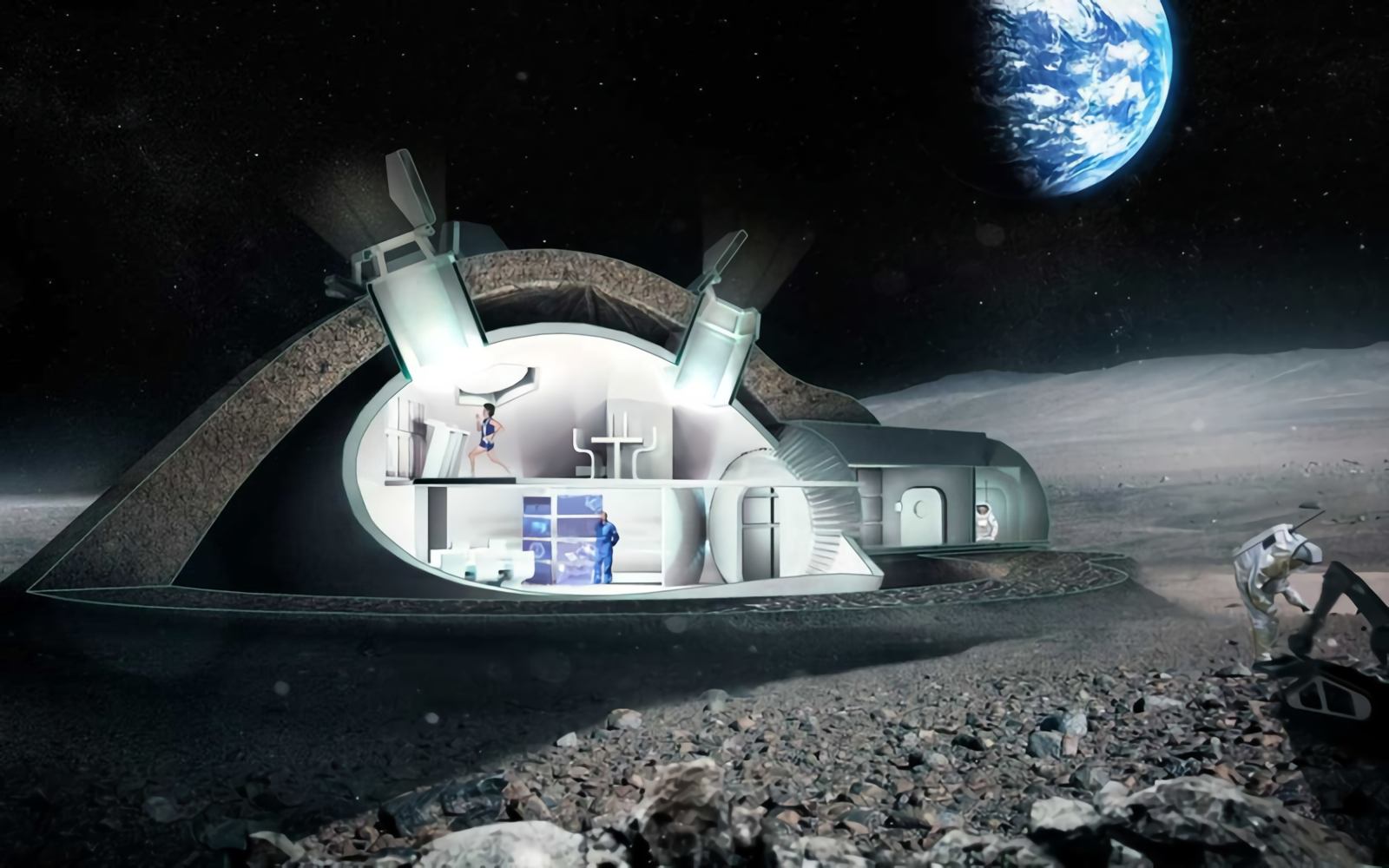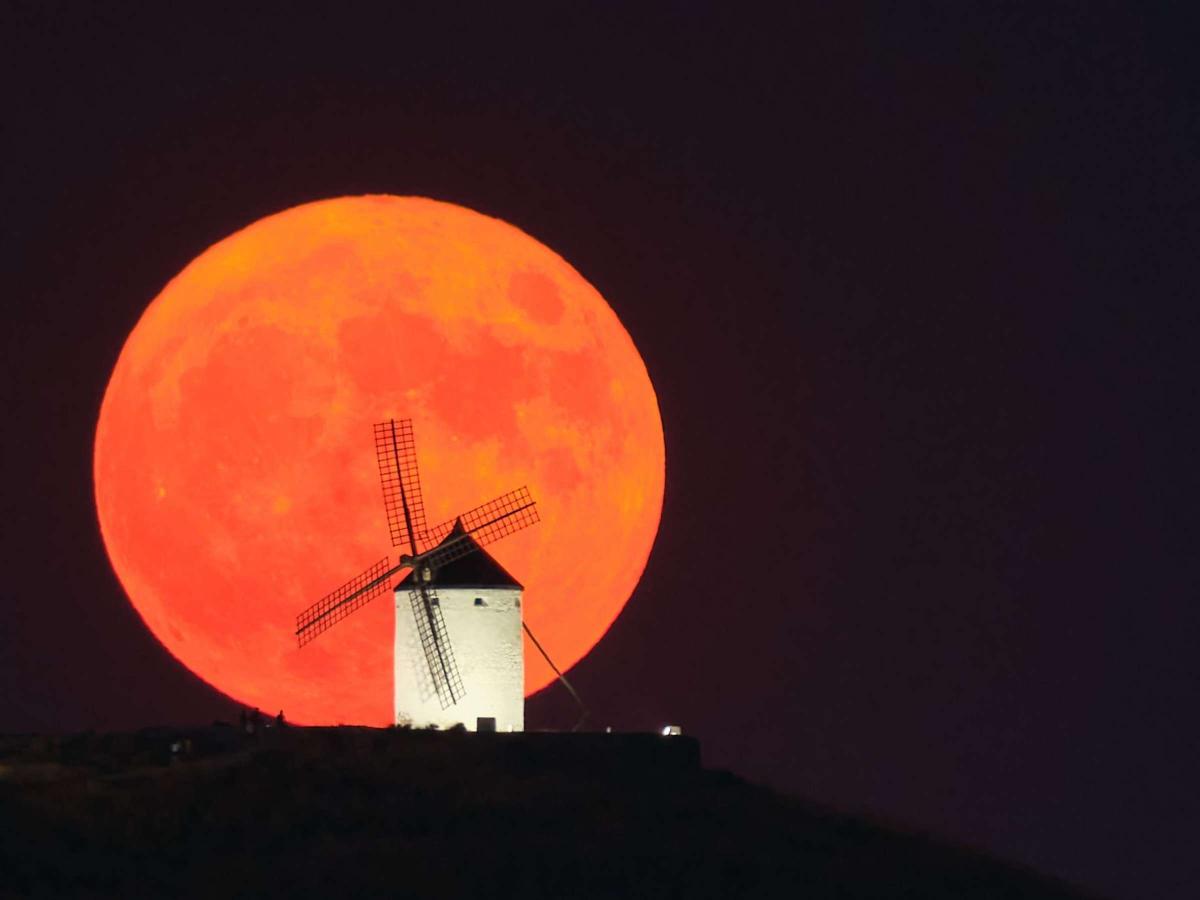It’s been decades since humans last visited the Moon, but that could change soon. That’s because several space organizations have recently announced plans to send humans to the Moon, and unlike previous trips, they want to really settle there. The plan is to set up bases on the Moon’s surface and in orbit around it. However, what may these lunar outposts really resemble? Where will they acquire the supplies they need?
Apollo 11‘s first lunar landing was 50 years ago, marking a major milestone in human spaceflight. The next logical step would be to begin lunar colonization. Due to the fact that the Moon still contains valuable resources like helium-3 and rare metals, it also serves as a crucial staging area for missions to Mars and beyond.
Thus, there has been a resurgence in the Moon Race. This time around, material economic and geopolitical objectives are at the forefront, rather than political considerations. Major space powers and private enterprises are developing ideas and technology for future lunar orbits and surface stations.
The long-fictionalized “Moon Base Alpha” is therefore taking on more concrete shape, and may become a reality within the next 20 to 30 years.
Why do we want to go back to the Moon?

New beginnings on the Moon
Humans have only ever stepped foot on the Moon, yet it is the first and only extraterrestrial celestial body we have ever explored. When Apollo 11 landed on the Moon for the first time in July 1969, people all across the globe applauded in response. At the time, many people thought that we would soon have outposts on the Moon and possibly colonies on Mars.
The Moon takes a back seat
But the excitement didn’t last long, and in 1972 the United States government abruptly scrapped the Apollo program once again, after only six landings and a total of twelve astronauts. All three remaining missions were scrapped. After the United States and the Soviet Union won the historic and politically significant race to the Moon, many American leaders, including President Richard Nixon, decided that further space exploration was no longer a priority.
The Moon and its exploration have been put on the back burner since then. Few orbiter probes remain in Earth’s satellite orbit, but the information they provide from afar is invaluable. However, landings have not occurred for decades, not even with unmanned probes. That all changed in 2013 when the Chinese spacecraft Chang’e 3 and the lunar rover Hutu touched down on the Moon for the first time in four decades. The first two unmanned missions to the far side of the Moon—Chang’e 4 and Hutu 2—landed in January 2019. Even still, no one has set foot on the Moon since 1972.
Alluring raw materials
However, in the meanwhile, there is activity once again in terms of lunar missions, as many space agencies and commercial organizations have revealed plans to send people to the Moon in the near future. However, the current objective is a lengthier, and probably even permanent, human presence aboard Earth’s satellite, in contrast to the flying visits of the Apollo missions.
Another deviation from the Apollo period is that the stakes are now material, economic, and technological benefits rather than a race of political systems. One reason to go to the Moon is all the precious metals and minerals it contains, including iridium. Due mostly to meteorite impacts, they have collected in the lunar regolith. Desire may also be sparked by helium-3, an exceptionally uncommon isotope of the noble gas helium. We’ll need it for things like coolants, measuring devices, and potential fusion reactor coolants, and the Moon has just what we need. Several corporations have declared their future plans for “Moon mining.”
The significance of Moon
In addition, the Moon’s strategic value lies in the fact that it might be used as a launching pad for human trips to Mars and beyond due to the much reduced rocket fuel needs afforded by the Moon’s low gravity. Telescopes and other observatories might potentially help boost space exploration efforts from the Moon. This is because, in particular, the far side of the Moon provides complete protection from any terrestrial disturbance.
Finally, the potential for profit from well-heeled space travelers is exciting. Elon Musk, the creator of SpaceX, revealed his company’s first lunar tourist in 2018: Japanese tycoon Yusaku Maezawa, who paid millions of dollars for passage for himself and a large group of friends on SpaceX’s first voyage to the Moon in 2017. In 2023, we want to achieve lunar orbit.
Thus, the Moon is now again a very appealing vacation spot.
Moon Village and Lunar Gateway
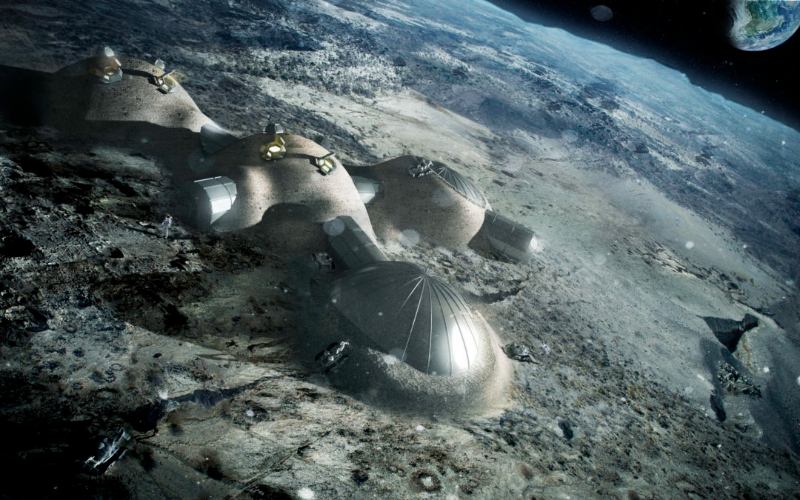
New Moon missions are in the works
When will the world learn the truth about the space countries’ bold new Moon programs? It seemed to be getting serious after 10 years of lofty intentions that never materialized. The United States, the European Union, China, and Russia are all planning missions over the next several years to be ready for the eventual return of humans to the Moon and the eventual establishment of a lunar outpost.
Everyone living in their own “Moon Village”
Jan Wörner, the head of the European Space Agency, proposed the idea of a Moon Village in 2016. This would be a multi-national outpost on Earth’s satellite, available for any and all uses. Her goal is to set up shop on the Moon permanently. Science and fundamental research, economic operations like raw material extraction, and even tourism might all be conducted by participants at this permanent lunar outpost.
Robots and autonomous rovers might launch the first phases of construction for this lunar outpost, with human astronauts joining in later. One major benefit of this plan is that it may be launched with very few resources. A number of nations are currently making preparations to send modest land missions, so that’s where we can begin. Afterwards, bigger initiatives might be built upon that foundation and include worldwide collaboration. As such, the lunar town has the potential to serve as the ISS’s successor, although one that is located on the Moon rather than in Earth’s orbit.
America: We’re here to stay this time
In December 2017, the United States issued a directive making a trip back to the Moon and subsequent trips to Mars a top priority for the American space program. Rather than just leaving our mark this time, we want to lay the groundwork for future exploration of Mars and beyond.
We are taking cutting-edge technology and systems to the Moon in order to study previously inaccessible regions, said NASA Administrator Jim Bridenstine. We want to settle on the Moon this time, unlike Apollo. Our next giant step into space will be taken after that.
Lunar Gateway
In the 2020s, NASA hopes to realize its goal of constructing a lunar “gateway,” or space station in lunar orbit. Because of this gateway, we will be able to establish a strong foothold in cislunar space and more effectively investigate the Moon and its potential benefits. From there, we want to launch manned missions to the lunar surface.
In the same way that the ISS was built in increments, this next orbiting outpost will also be composed of modular components. The parts will be sent into orbit by NASA’s Space Launch System (SLS) and carried there aboard the Orion spacecraft. The core propulsion and supply portion of the station might be placed in lunar orbit really soon. In 2024, astronauts will have access to the first module that doubles as a home and lab. Once that happens, personnel may stay at the station for 30 or 60 days at a time to do their jobs.
Assisted landing by a private party
NASA is hoping to recruit commercial enterprises to help with the trip from the ISS to the Moon’s surface. Six businesses are competing in a tender announced at the end of 2018 under the NextSTEP initiative. The objective is to design a method that can transport, land, and return to the space station from the lunar surface.
In terms of requirements for future landing modules, durability and reusability are high on the list. In contrast to the Apollo lander modules, whose whole underpinnings were left on the Moon and are still there today, future landers will be entirely reusable. After that, they’ll be refueled either on the ground or in space. According to NASA Administrator Jim Bridenstine, we aim to return humans to the lunar surface within the next decade, but this time we want to do it sustainably.
How would a Moon base look like?
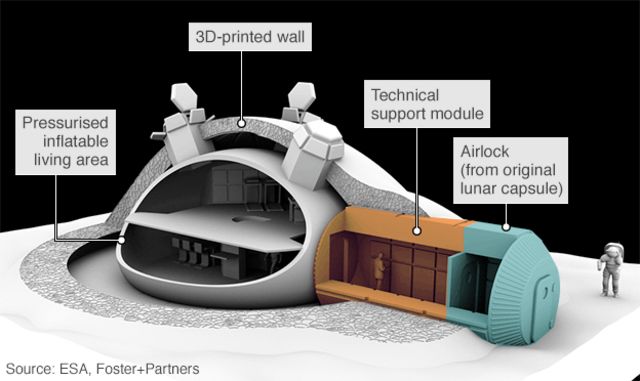
Lunar selters made of lava rock and regolith igloos
Those who choose to settle on the Moon in the future will be met with a harsh and perhaps lethal environment. As a matter of fact, the Moon is not exactly a warm and fuzzy location to spend some time. There is no magnetic field, no atmosphere to shield you from the elements, and no oxygen. Those who choose to remain on Earth’s surface are unprotected from the Sun’s radiation, the solar wind, and the meteorite showers. Simultaneously, there are dramatic shifts in temperature: If the Sun is out, everything will get to be around 120 degrees. Temperatures, on the other hand, dip to a chilly minus 170 degrees in the shadow and on starry evenings.
Therefore, the primary function of a lunar base is to offer shelter from these dangerous conditions. I mean, how? Obviously, an inflatable dome like the one seen in “The Martian,” a science fiction novel and film, would not be sufficient for a lunar outpost. A shield from radiation or meteors could not be created with this. Astronauts need sturdy walls in their lunar habitat if they are going to be able to stay there for an extended period of time.
Living and working in lunar lava caves
Lava caverns, which are found naturally on the Moon, might be used as a safe haven. Underground craters and tubes were formed by the Moon’s early volcanic activity. In 2017, scientists found a massive lava tunnel in the lunar Ocean of Storms (Oceanus Procellarum). It stretches for 31 miles (50 km) and is up to 3300 feet in height and width, providing enough room for an entire lunar metropolis. A hole with a diameter of around 165 feet (50 m) provides access to the surface.
Lava caverns near the Moon’s polar area, though, might be an even better fit. This is due to the presence of water ice, which may be used to provide both potable water and fuel for the astronauts. Philolaus crater, an impact crater of 44 miles (70 km) in size at 72 degrees north latitude, has been mapped and explored by scientists, and many spots inside it have been identified as promising candidates. Multiple shadowy crevices on the crater floor suggest the presence of lava caverns.
Moon bricks from the solar oven
We may also use Moon dust to construct the requisite defensive fortifications. DLR (German Aerospace Center) scientists in Cologne are already hard at work on a plan to fire regolith into a Moon block. They are focusing sunlight into a powerful beam using curved mirrors. The thin layer of volcanic grains used as a regolith mimic is heated to temperatures of over 1,000 degrees using this method.
Extreme heat causes the material to sinter, which means the granules adhere together and create a solid layer. Layer by layer, like a 3D printer, solid components may be created from regolith. Already, with today’s technology, we have access to a substance approximately as stable as gypsum. However, with more improvement, lunar regolith might be made into a construction material with the strength of concrete.
However, even with their solar 3D printer, it still takes the team around five hours to manufacture a single regolith building block. It would take around 10,000 of these bricks to create a protective shell around a lunar igloo. Months would pass before it could be accomplished. However, if many sintering plants were to be run in parallel on the lunar surface, the process may be sped up.
3D printing with regolith sludge
Together with the British firm Monolite, ESA researchers are researching an alternative method. First, a slurry is made by combining the regolith mimic with a magnesium oxide solution. This allows the document to be printed out. The business uses a binding salt to turn the substance into a stone-like solid, turning it from a liquid into “ink” for solid creations.
With this technique, the team can print and complete 6.5 feet (2 m) of material in an hour. If the next-generation design can achieve 11.5 feet (3.50 m) per hour, a whole skyscraper might be constructed in one week. Regolith material is used to make each block, which results in each one weighing 1.5 metric tons and featuring many holes throughout. It has not yet been determined, however, whether the building method would hold up in the lunar vacuum and dramatic temperature swings.
Catenary arch igloo design
A plan for the next ESA lunar outpost already exists, even though the building material has not been agreed upon. British superstar architect Norman Foster and his team designed it. The mathematical-physical theory of the catenary arch was adhered to in order to make the lunar dwellings as stable as possible. Arches are very stable because their shape, a parabola, takes the route of least energy.
In this way, the homes on the Moon seem more like igloos than like regular residences. They too are a hybrid of tube and dome shapes. The inflated inner shell serves as the structural base for these Moon igloos. This is the outline, which the robots are currently covering with regolith bricks from the outside. Each habitation module on the Moon will have enough room for four people and shield them from cosmic rays, meteorites, and temperature swings.
Water and oxygen
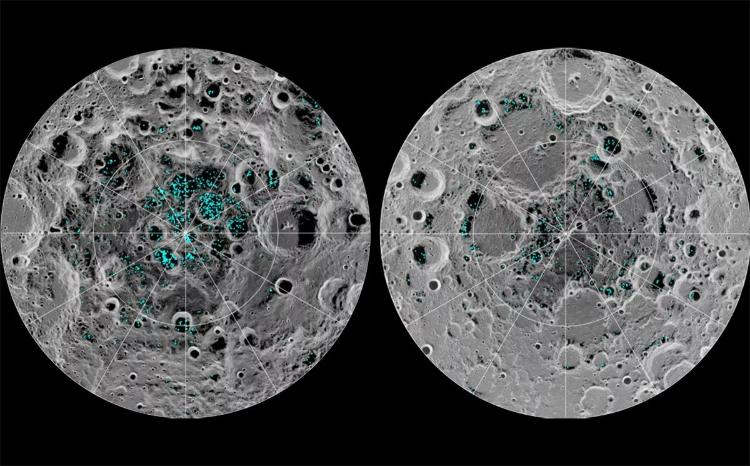
Raw material sources: crater ice and regolith
Assuming the lunar base is complete and ready for its first residents. Then, at the very least, there’s the issue of getting fuel, water, oxygen, and food to the astronauts. It would be impractical and prohibitively costly to transport all of these materials from the Earth. Therefore, it is evident that a lunar colony, in order to exist, must make use of on-site resources.
Ice from the lunar craters
The most straightforward answer concerns the provision of water: if future lunar outposts are constructed in the polar regions of Earth’s satellite, sufficient water ice will be found there. In 2010, data from India’s Chandrayaan-1 lunar spacecraft indicated that there are ice layers a 3.2 ft (1 m) deep in the craters near the lunar north pole. Present evidence suggests there may be roughly 10 billion metric tons of water at each pole.
However, the exact amount and composition of the ice found in the lunar dust have not been determined. To this end, the possibility of obtaining potable water from ice remains open. In the next several years, this will be answered by a number of robotic lunar missions. To be fair, the needs of a lunar outpost wouldn’t be very high at first: NASA suggests that a crew of four may get by on just a few dozens of metric tons of water each year.
Water from the crater ice might be collected using solar energy. Using parabolic reflectors, the radiation may be focused and directed to evaporate the ice only in the parts that were shielded by the foil. In the event that this water vapor is dispersed and cooled once again, it condenses into potable water. Alternatively, robotic excavators may harvest ice, which could subsequently be melted or evaporated in stationary solar furnaces.
Regolith as a raw material supplier
Water could be retrieved from the regolith on the Moon even if there were no ice formations. This is because, as was recently discovered by spectrometer data from the Lunar Reconnaissance Orbiter, water is bonded to the rock as hydroxyl (OH) practically everywhere on the lunar surface. This trapped water is also located away from the lunar poles, making it a more accommodating site for a lunar outpost than the polar craters.
NASA’s Goddard Space Flight Center scientist William Farrell says that after being blasted by the solar wind, every rock on the Moon has the potential to generate water. According to the findings of his group, this bound water is produced by a chemical process in the regolith. Oxygen-containing minerals in lunar rock have their connections broken by the solar wind’s intense energy. Since reactive oxygen radicals are created, they may “grab” hydrogen from their surroundings to form hydroxyl.
Oxygen and water from the lunar soil
How, therefore, might this potentially hydrous rock be mined for potable water? Again, researchers showed that solar heat was crucial on a mock journey to Hawaii. At temperatures of around 900 degrees Fahrenheit, the regolith-like volcanic dust began to shine. Furthermore, passing hydrogen or methane across it causes it to react with the oxygen in the regolith to produce water. NASA estimates that 119 grams of water may be recovered from one kilogram of the most abundant lunar mineral, ilmenite (FeTiO3).
As a useful byproduct, the astronauts’ breathing air’s oxygen may be extracted from the regolith using this method. When water vapor is produced during heating, it must be separated back into its original hydrogen and oxygen components. One kilogram of ilmenite could provide enough oxygen for 106 grams of breathing space, at least in principle. However, studies are currently being conducted to ascertain which approach is most appropriate and how oxygen and water may be created using the fewest resources and the least amount of energy.
Electricity and fuel

Generating power on the Moon
A lunar outpost needs its own power plant if its inhabitants are to survive. Electricity is essential for astronauts because it powers their heaters, lights, and other electronic gear. They should be able to use local resources to produce fuel for the landing shuttles and lunar vehicles.
Electricity from the Sun
Sunlight is a simple and effective way to get energy. Photovoltaic systems have a long history of usage in space exploration, and the Moon is a suitable location for them. The catch is, however: Since one lunar day is equivalent to 29 Earth days, the Moon is always in the dark for two weeks when the Sun isn’t available to provide energy. Aside from that, the Earth sometimes shuts out the Sun for a few hours during solar eclipses, which happen several times a year.
Scientists, however, have come up with answers for this as well: Aidan Cowley of the European Space Agency says that throughout the day, there is sufficient solar energy to split water into its component parts of hydrogen and oxygen. We could convert these gases back into water and use them to generate energy when the Moon was asleep. In theory, this might work by having fuel cells soak up sunlight throughout the day and then churn out power after the Sun goes down.
In a perfect world, hydrogen, oxygen, and the resultant water would all be recycled indefinitely inside this system, forming a closed cycle. The only other component needed is sunshine. According to David Bents of the Glenn Research Center, who studied these regenerative fuel cells for NASA a few years ago, if nothing breaks or wears out, this may operate indefinitely without having to be recharged.
Moon as a gas station
Among the many resources needed for space flight, fuel is one of the heaviest and most vital. As of now, it constitutes the vast majority of the total launch mass of a rocket, and thus, a significant proportion of the associated launch expenses. A lunar outpost would have to generate its own fuel to be cost-effective.
In addition, a lunar outpost is seen as crucial by space organizations as preparation for Mars and beyond. For this reason, NASA’s lunar orbiting station Lunar Gateway will, in the long run, serve as a refueling station for space trips. After all, space probes won’t have to struggle against Earth’s gravity to lift their entire fuel load into space if they only do it in lunar orbit. Concepts for such “refueling stations” in lunar orbit are already being developed by a number of academic organizations and businesses.
Even if these filling stations are built, the issue of where to get gasoline for them remains. Once again, the regolith of the Moon is being seen as the best option. It contains the ingredients for a standard rocket fuel, hydrogen, and oxygen, and can be extracted using the Sun’s heat. The upper burn stage of the Saturn V, the Atlas 5, and the engines of the space shuttles have all employed liquid oxygen and hydrogen. However, this fuel combination is also used by cutting-edge rockets like the European Ariane 5 rocket.
What is the source of the food on the Moon?
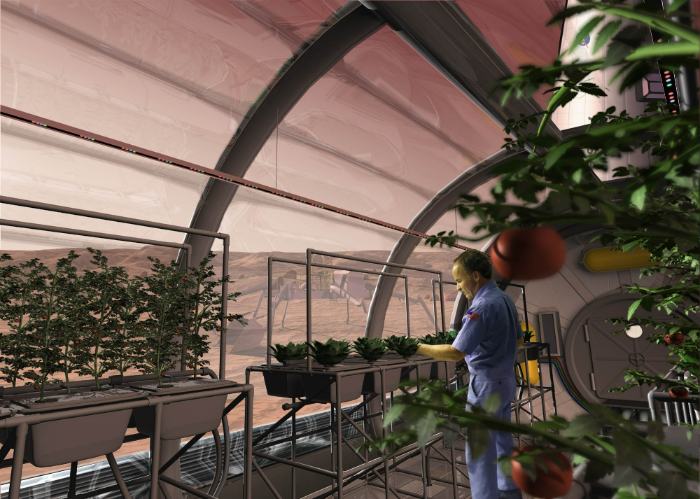
Plants grown in the Moon
That remains the issue of sustenance for the lunar colonists of the future. For a long time, astronauts (including those living on the ISS) have needed to rely on supplies sent all the way from Earth. But the logistics and prices of a lunar colony would not allow for something that is currently difficult and costly in Earth orbit. Because of this, it is essential that the lunar station’s personnel generate as much as possible inside the facility itself.
Vegetables cultivated on lunar soil
Vegetables and fruits, at least, could make this simpler than previously believed. Plants were successfully grown by Dutch researchers in 2016 using lunar and Martian soil replicas. The difficulty is that the regolith has almost no nutrition since it lacks organic components due to the absence of life on the Moon. However, the astronauts’ own waste products, like urine or leftover food, might make up for the lack of these organic ingredients.
To secure the success of their culture experiment, Wieger Wamelink and his colleagues sent in soil microorganisms from Earth to further enrich their synthetic lunar regolith with such organic material. They then planted a variety of vegetables and grains including tomatoes, peas, rye, radishes, leeks, spinach, lettuce, cress, quinoa, and chives. The end result was that plant life flourished in the artificial lunar soil. About half as much biomass was created as on Earth, but there was still plenty to harvest.
Orbit and Antarctica are being used for test crops
On the International Space Station, astronauts are attempting a new approach. Since 2015, the station has included a miniature greenhouse. Plants are nourished by a nutrient solution and grown in a calcareous mineral mass. Bright red, blue, and green LEDs light up the entire object. The ISS crew has already gotten their hands on fresh lettuce thanks to this “veggie” technology. A completely autonomous automated plant-growing system is the next step. More than 180 sensors monitor the soil, air, and water supplies separately and adjust the flow as needed.
Plant growth on the Moon is being tested again in the Antarctic. The EDEN-ISS greenhouse container has been stationed in the Antarctic since the beginning of 2018, around 1300 feet (400 m) from the German Neumayer III research station. Plants like lettuce, radishes, and cucumbers thrive here because the system is comparable to the one used on the space station. Scientists working in the Arctic have already harvested their first crop, which they have consumed with great gusto.
Gioia Massa, a NASA researcher, notes that the farther and longer people go from Earth, the more important it is to be able to produce plants for food, for processing the atmosphere, and for psychology. So, plant life is crucial to any future extended space missions.
It’s a matter of compromises
The people of the future lunar outpost, however, will need more than just lettuce and cucumbers to sustain themselves. Unfortunately, supplies of food will still need to be sent in from Earth. Therefore, a trip back to the Moon and the construction of a lunar station will not be a cheap luxury. What ultimately matters is whether or not the benefits and insights acquired are worth these expenses.


